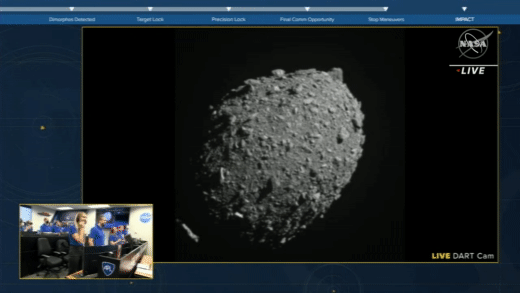Watch the moment NASA’s DART spacecraft crashed into an asteroid
The project is the first time humanity has tested a planetary asteroid defense system.

NASA is celebrating the success of humanity’s first test of a planetary defense system: crashing a spacecraft into an asteroid in order to change its orbit. NASA’s Double Asteroid Redirection Test spacecraft, or DART, was intentionally smashed into the asteroid Dimorphos at 7:14 p.m. US Eastern time last night, spelling the end to a successful 10-month mission.
A small camera mounted on DART livestreamed the spacecraft’s steady progress toward the 160-meter-wide asteroid, located about 6.8 million miles from Earth, back to controllers based at the Johns Hopkins University Applied Physics Laboratory. The team cheered as Dimorphos grew closer and closer, before the livestream cut out on impact with the asteroid.
The strike was “basically a bull’s-eye,” mission systems engineer Elena Adams said. You can watch the livestream for yourself to see the exact moment DART struck Dimorphos. And for a sense of scale, last year the collision was described by Tom Statler, DART’s program scientist, as a golf cart traveling at 15,000 miles an hour smashing into the side of a football stadium.
The mission, which was launched in November last year, demonstrates a way for humanity to protect itself from asteroids. While Dimorphos itself had not been on course to crash into Earth, the project demonstrates NASA’s ability to deflect similar asteroids in the future.
Researchers believe the crash could have shortened Dimorphos’s orbit by around 10 minutes, which is enough to make a significant difference to the path an asteroid travels. NASA administrator Bill Nelson called the mission an “unprecedented success for planetary defense.”
The next step is to study the asteroid using telescopes on Earth to confirm that DART’s impact altered the its orbit around a larger asteroid called Didymos.
Deep Dive
Space
How to safely watch and photograph the total solar eclipse
The solar eclipse this Monday, April 8, will be visible to millions. Here’s how to make the most of your experience.
How scientists are using quantum squeezing to push the limits of their sensors
Fuzziness may rule the quantum realm, but it can be manipulated to our advantage.
The race to fix space-weather forecasting before next big solar storm hits
Solar activity can knock satellites off track, raising the risk of collisions. Scientists are hoping improved atmospheric models will help.
Stay connected
Get the latest updates from
MIT Technology Review
Discover special offers, top stories, upcoming events, and more.